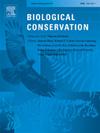波士顿郊区的蜜蜂和本地花卉访客:共存与保护策略评估
IF 4.9
1区 环境科学与生态学
Q1 BIODIVERSITY CONSERVATION
引用次数: 0
摘要
由于担心非本地蜜蜂(Apis mellifera)可能会干扰本地授粉昆虫并与之竞争,各国政府正在考虑限制蜜蜂蜂巢。然而,决策过程中往往缺乏有关蜜蜂和本地昆虫具体访花模式的地方尺度信息。为了解决这个问题,我们在美国马萨诸塞州牛顿市观察了昆虫对 391 种本地和非本地植物的取食情况。我们发现,蜜蜂和本地蜜蜂(包括熊蜂和独居蜂)访问了各种各样的栽培植物、本地植物、外来植物和授粉植物。栽培植物的总体访问量高于野生植物物种,但访问量最大的植物通常是野生植物物种,蜜蜂和本地授粉昆虫混合访问。对于许多植物物种,尤其是栽培植物,我们没有观察到任何花朵被拜访。这些发现表明,在这个郊区地点,花卉资源似乎足以让蜜蜂、熊蜂和其他本地蜜蜂共存。我们建议居民和政府官员在改变蜜蜂管理条例之前,考虑进行类似的简单调查。在牛顿这样的情况下,除了评估对蜜蜂蜂巢的管理条例外,我们还建议官员们考虑如何减少对本地花卉昆虫的其他威胁,如除草剂和杀虫剂的使用以及栖息地的丧失,同时还可以种植授粉者花园和野花草地,以增加可用资源。本文章由计算机程序翻译,如有差异,请以英文原文为准。
Honey bees and native flower visitors in a Boston suburb: Assessing coexistence and conservation strategies
Concern that non-native honey bees (Apis mellifera) may disrupt and outcompete native pollinators is leading governments to consider restricting honey bee hives. However, local-scale information on the specific flower visitation patterns of honey bees and native insects is often absent from the decision-making process. To address this concern, we observed insect visitation to 391 native and non-native plant species in Newton, Massachusetts (USA), a Boston suburb with extensive conservation areas and public and private gardens. We found that honey bees and native bees, including bumblebees and solitary bees, visited a wide variety of cultivated, native, adventive, and pollinator garden plants. Cultivated plants received more overall visits than wild plant species, but the most visited plants were often wild plant species with mixed visitation by honey bees and native pollinators. For many plant species, particularly cultivated plants, we did not observe any flower visitation. These findings suggest that at this suburban location, floral resources seem sufficient to allow coexistence between honey bees, bumblebees and other native bees. We suggest that residents and government officials consider doing simple surveys like this one prior to altering regulations of honey bees. In situations like Newton, in addition to evaluating regulations on honey bee hives, we suggest officials consider ways to reduce other threats to native flower-visiting insects, such as herbicide and pesticide use and habitat loss, while also planting pollinator gardens and wildflower meadows to increase available resources.
求助全文
通过发布文献求助,成功后即可免费获取论文全文。
去求助
来源期刊

Biological Conservation
环境科学-环境科学
CiteScore
10.20
自引率
3.40%
发文量
295
审稿时长
61 days
期刊介绍:
Biological Conservation is an international leading journal in the discipline of conservation biology. The journal publishes articles spanning a diverse range of fields that contribute to the biological, sociological, and economic dimensions of conservation and natural resource management. The primary aim of Biological Conservation is the publication of high-quality papers that advance the science and practice of conservation, or which demonstrate the application of conservation principles for natural resource management and policy. Therefore it will be of interest to a broad international readership.
 求助内容:
求助内容: 应助结果提醒方式:
应助结果提醒方式:


